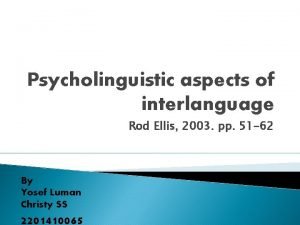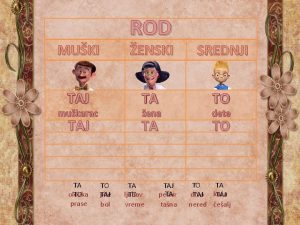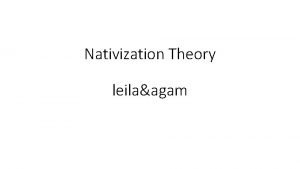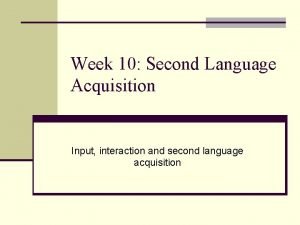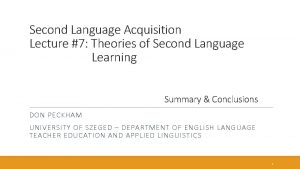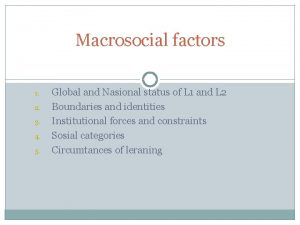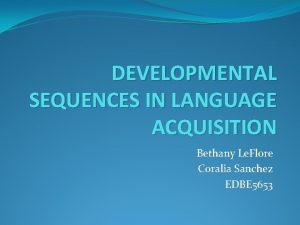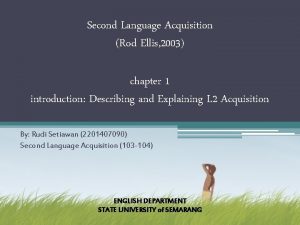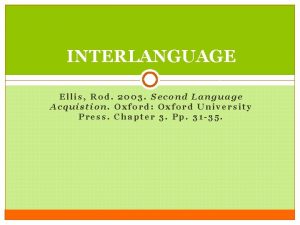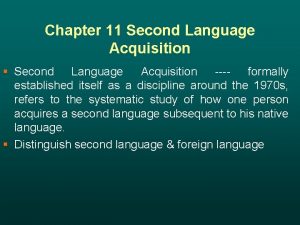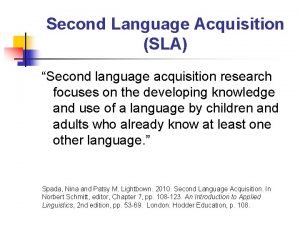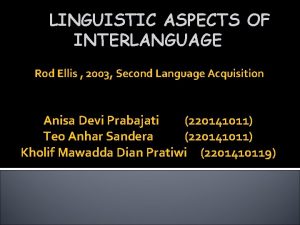Second Language Acquisition Rod Ellis 2003 chapter 2










- Slides: 10

Second Language Acquisition (Rod Ellis, 2003) chapter 2 The Nature of Learner Language By: Rudi Setiawan (2201407090) Second Language Acquisition (103 -104) ENGLISH DEPARTMENT STATE UNIVERSITY of SEMARANG

Errors and Error Analysis Identifying errors Definition errors and mistakes Errors reflect gaps in a learner’s knowledge; they occur because learnedoesn’t know what is correct. Mistakes reflect occasional lapses in performance; they occur because, in a particular instance, the learner is unable to perform what he or she knows. �To identify errors we have to compare the sentences learners produce with r what seem to be the normal or correct sentences in the traffic (Rod Ellis: 2003: 15)

Errors and Error Analysis Describing errors There are several ways of describing errors 1. Classify errors into grammatical categories. 2. Identify general ways in which the learners’ utterance differ from the reconstructed targetlanguage utterances. (Rod Ellis: 2003: 18)

Errors and Error Analysis Explaining errors Errors have different sources, they are: 1. Omission errors 2. Overgeneralization errors 3. Transfer errors (Rod Ellis: 2003: 18 -19)

Errors and Error Analysis Errror evaluation Some errors, known as global errors, violate the overall structure of a sentence and for this reason may make it difficult to process. Other errors, known as local errors, affect only a single constituent in the sentence (for example, the verb) and are, perhaps, less likely to create any procxessing problems. (Rod Ellis: 2003: 19 -20)

Developmental Patterns The early stage of L 2 acquisition Silent period; that is, they make no attempt to say anything to begin with. They may learning language just through listening to or reading it. The silent period may serve as a preparation for subsequent production. Acquisition order. In time, though, learners do begin to learn the grammar of the L 2. do learners acquire the grammatical structures of an L 2 in a definite order? Sequence of acquisition. Do learners learn such structuress in a single step or do they proceed through a number of interim stages before they master the target structure? (Rod Ellis: 2003: 20 -21)

Developmental Patterns The order of acquisition To investigate the order of acquisition, researchers choose number of grammatical structure to study. Then collect samples of learner language and identify how accurately each feature is used by different learners. This enable them to arrive an accuracy order. (Rod Ellis: 2003: 21 -22)

Developmental Patterns Sequence of Acquisition The acquisition of a particular grammatical structure therefore, must be seen as process involving transitional construction. Since sequence are instructive because they reveal that the use of a correct structural form. Acquisition follow a U-shaped course of development; that is, initially learners may display a high level of accuracy only to apparently regress later before once again performing in accordance with target language norms. (Rod Ellis: 2003: 23 -24)

Developmental Patterns Some Implications The work on developmental patterns is important for another reason. It suggests that linguistic features (particularly grammatical ones) are inherently easier to learn than others. (Rod Ellis: 2003: 24 -25)

Variability in Learner Language We have seen that learner language is systematic , we also have seen that learner language is variable. At any given stage of development, learners sometimes employ one form and sometimes another. Thus, one type of error may alternate with another type: i. e : yesterday the thief steal the suitcase yesterday the thief stealing the suitcase Thus, it appears that learners vary in their use of the L 2 according to Linguistic Context. (Rod Ellis: 2003: 25 -29)
 Difference between second language and foreign language
Difference between second language and foreign language Psycholinguistic aspects of interlanguage
Psycholinguistic aspects of interlanguage Rod ellis 2003
Rod ellis 2003 Muski i zenski rod imenica u francuskom jeziku
Muski i zenski rod imenica u francuskom jeziku What is nativization model
What is nativization model Language
Language Teori second language acquisition
Teori second language acquisition 7 theories of second language acquisition
7 theories of second language acquisition Macro social factors
Macro social factors Developmental sequences in second language acquisition
Developmental sequences in second language acquisition роберт ладо
роберт ладо

